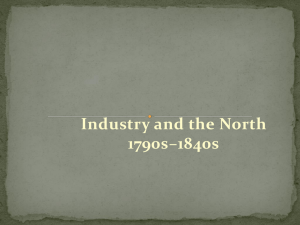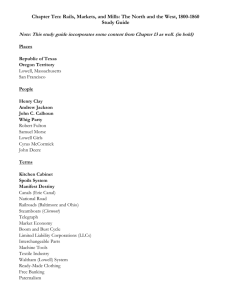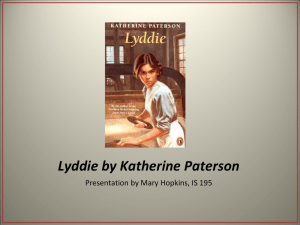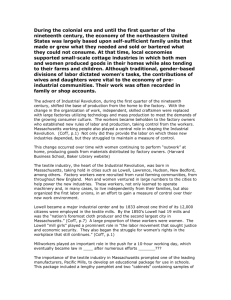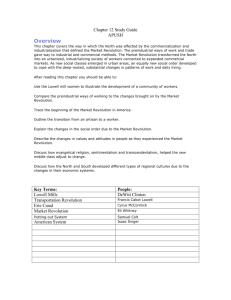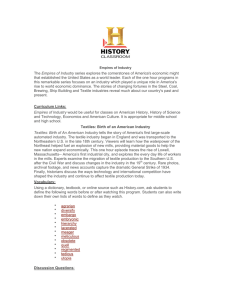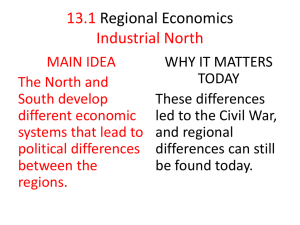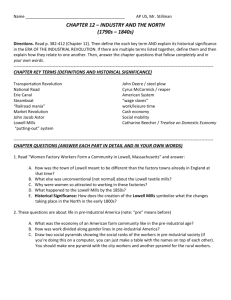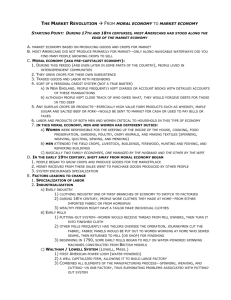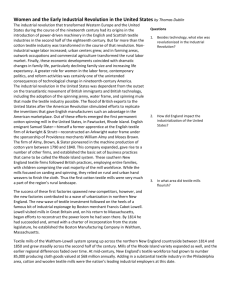Part One - Bakersfield College
advertisement
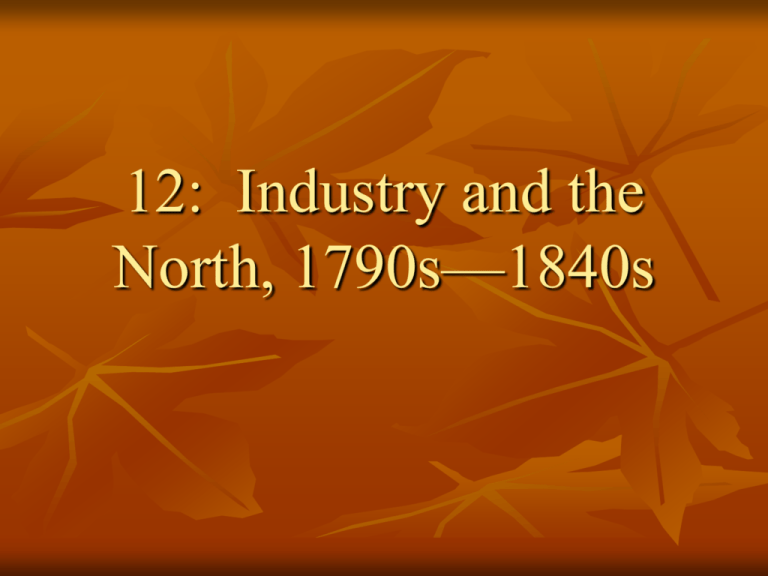
12: Industry and the North, 1790s—1840s Henry David Thoreau’s Cabin at Walden pond “Is a democracy, such as we know it, the last improvement possible in a government? Is it not possible to take a step further towards recognizing and organizing the rights of man? There will never be a free and enlightened State until the State comes to recognize the individual as a higher and independent power, from which all its own power and authority are derived, and treats him accordingly.” Henry David Thoreau Henry David Thoreau If Christ should appear on earth he would on all hands be denounced as a mistaken, misguided man, insane and crazed. I believe the mind can be permanently profaned by the habit of attending to trivial things. Under a government which imprisons any unjustly, the true place for a just man is also a prison. Not only must we be good, but we must also be good for something. Ralph Waldo Emerson, 1803 - 1888 Ralph Waldo Emerson If you put a chain around the neck of a slave, the other end fastens itself around your own. We are always getting ready to live but never living. A foolish consistency is the hobgoblin of little minds, adored by little statesmen and philosophers and divines. With consistency a great soul has simply nothing to do. . . . To be great is to be misunderstood. The power of Love, as the basis of a State, has never been tried. . . There will always be a government of force where men are selfish. As soon as beauty is sought not from religion and love, but for pleasure, it degrades the seeker. Chapter Focus Questions What changes in preindustrial life and work were caused by the market revolution? This chapter argues that when people begin doing new kinds of work, their beliefs and attitudes change. Give three examples of such changes described in the chapter. Can you think of other examples? Discuss the opinion offered by historian David Potter that mass production has been an important democratizing force in American politics. Do you agree? Why or why not? Consider the portrait of the nineteenth-century middleclass family offered in this chapter and imagine yourself as a member of such a family. What new aspects of family relations would you welcome? Which would be difficult? Why? Chronology 1790 1793 1798 1807 1810 1812 1813 1815 1816 Samuel Slater’s first mill opens in RI Cotton gin invented Eli Whitney contracts with federal gov't for 10, 000 rifles [interchangeable parts] Embargo Act excludes British manufactures Francis Cabot Lowell tours British textile factories Micajah Pratt begins his own shoe business in Lynn, MA Francis Cabot Lowell raises $300, 000 to build his first cotton textile factory at Waltham, MA War of 1812 ends British competition in manufactures resumes First protective tariff 1820s 1823 1824 1825 1830 1834 1836 1841 1845 1847 Large-scale outwork networks develop in New England Lowell mills open John Hall successfully achieves interchangeable parts at Harpers Ferry armory Erie Canal opens Charles G. Finney’s Rochester in revivals First strike at Lowell mills [led by women] Ralph Waldo Emerson lecture "Nature" published Catharine Beecher’s Treatise on Domestic Economy published New England Female Labor Reform Association formed New Hampshire passes first ten-hour-day law RECOMMENDED Paul Boller, American Transcendentalism, 1830-1860 (1974) Paul Johnson, A Shopkeeper's Millennium: Society and Revivals in Rochester, New York, 1815-1837 (1978) Edward Pessen, Riches, Class, and power before the Civil War (1973) R. D. Richardson Jr., Henry Thoreau: A Life of the Mind (1986) A: Women Factory Workers Form a Community Young women from New England farms worked in the Lowell textile mills. Initially, the women found the work a welcome change from farm routine, but later conflict arose with their employers. By the 1830s, mill owners cut wages and ended their paternalistic practices. The result was strikes and the replacement of the young women with more manageable Irish immigrants. B: Preindustrial Ways of Working The Springer Family and Rural Life The family of Thomas and Elizabeth Springer of Mill Creek, Delaware illustrates the yeomen existence of farm families in the Mid-Atlantic states. The Springer family: sold dairy products, wool, and livestock in nearby Wilmington raised crops for family use and commercial sale participated in a local network of barter and mutual obligation The Family Labor System The traditional labor system put the entire family to work. The scarcity of cash led to a barter system for goods and services. In New England, many farm families engaged in outside work, often developing a skill such as shoemaking. Urban Artisans and Workers Urban craftsmen learned their trades through the European apprenticeship system. Young men worked as artisans until they had perfected their skills, becoming journeymen and possibly master craftsmen. Though women did skilled work, too, no apprenticeship system existed for them. Work for the urban craftsman: was a family affair was organized along patriarchal lines specialized in one area Patriarchy in Family, Work, and Society The father was head of the family and boss of the enterprise. Legally, the father owned all family property and was its representative in the larger society. Women were managers of the household and as informal assistants. The Social Order Preindustrial society fixed the place of people in the social order. Most artisans did not challenge the traditional authority of the wealthy. In the early 19th century, the market revolution undermined the traditional social order. C: The Market Revolution The Accumulation of Capital The market revolution was caused by rapid improvements in transportation, commercialization, and industrialization caused the market revolution. Merchants comprised the business community of the northern seaboard accumulating great wealth. Conflicts between 1807-1815 that disrupted United States trade with Europe led merchants to invest in local enterprises supplemented by banks and the government. Southern cotton produced by slaves bankrolled industrialization. The Putting-Out System In the early 19th century merchants “put out” raw goods in homes. In the case of shoe-making artisans: journeymen cut the leather wives and daughters bound the upper parts together the men stitched the shoe together Pegging boots by hand Central Workshops As demand grew, merchants like Micajah Pratt built central workshops and brought workers into Lynn, Massachusetts. Pratt modified the putting-out system providing greater control over the workforce and the flexibility to respond to changing economic conditions. The putting out system and the central workshops caused the decline of the artisan shop. The Spread of Commercial Markets As more workers became part of the putting out system: wages for piecework replaced bartering families bought mass-produced goods rather than making them at home. Commercialization did not happen immediately or in the same way across the nation. British Technology and American Industrialization The industrial revolution began in the British textile industry and created deplorable conditions. Samuel Slater slipped out of England bringing plans for a cotton-spinning factory. He built a mill that followed British custom by hiring women and children. New England was soon dotted with factories along its rivers. Early iron foundry near Baltimore, MD in 1828 Pittsburgh steel foundry, 1840s The Lowell Mills Francis C. Lowell studied British spinning machine. Lowell helped invent a power loom & built the 1st integrated cotton mill near Boston in 1814. The mill drove smaller competitors out of business. Lowell’s successors soon built an entire town to house the new enterprise. Lowell, MA mills about 1840 The Growth of Cotton Textile Manufacturing New England was the center of textile manufacturing Farmer’s daughters working in a power loom mill Family Mills Factories developed elaborate divisions of labor that set up a hierarchy of value and pay. Mills were run with strict schedules and with fines and penalties for workers who did not meet them. The shift to a precise timetable was a major change. Most mills were “family mills," where entire families would work and pool their wages. Communities developed antagonistic relationships with the mills, resenting the influx of transient workers and frequently looking down upon them. “The American System of Manufactures” The American system of manufacturing was based on interchangeable parts in the manufacturing of rifles developed by Eli Whitney, Simeon North, and John Hall. Standardization spread into other areas like sewing machines. The availability of these goods affected American thinking about democracy and equality. Americans could have mass-produced copies, indistinguishable from the originals. Boring rifle barrels at the Springfield, MA Armory A replica a Samuel F. B. Morse’s 1st telegraph instrument, 1835 Samuel F. B. Morse in Victorian NY City home, about 1870 D: From Artisan to Worker The Decline of the Artisans As artisans were turned into workers their lives were transformed. The putting out system destroyed the apprenticeship tradition in artisan production, replacing them with child labor. The older system of personal relationships between master and workers was replaced with an impersonal wage system. By subdividing tasks, masters could hire low-skill, lowwage women and children, denying opportunities to male artisans. As textile mills grew, they replaced women’s most reliable home occupation. Mechanization and Women’s Work The rise of the garment industry led many women to work sewing ready-made clothing for piece rates. So poorly paid were these tasks that women might work 15 to 18 hours a day. Women’s Work Women's work in 1837 was centered in the manufacture of hats, bonnets, boots and shoes. Time, Work, and Leisure Workers did not readily adjust to the demands of the factory. Though used to long hours, they were not acclimated to the strict regimen. Absenteeism was common among workers whose interests differed from their employers. A much more rigid separation between work and leisure developed. Leisure spots like taverns emerged, as did leisure activities like spectator sports. Changing Employer-Worker Relations The introduction of the cash economy led to the decline of the barter system. Worker contact with employers came through the pay envelope. Workers took advantage of the lack of ties to move about in search of better jobs. Laborers saw themselves as “free” - able to move about to new jobs and possessing the individualistic characteristics needed for success. MA Sp. Ct. Justice Lemuel Shaw – 1842 landmark case saying unions had legal right to exist and were not “conspiracies.” Early Strikes Owners cited worker individualism when they opposed government mandated protections and denounced unions. Most early strikes were unsuccessful. Women played significant roles in these early labor protests. 1860 Lynn, MA strike by 800 women shoemakers Castle Clinton at NY City – port of entry for immigrants 1840 - 1860 Philadelphia Bible Riots, June 1844 – anti-Catholic during 1844 presidential campaign E: A New Social Order Wealth and Class The market revolution ended the natural fixed social order that previously existed. The market revolution created a social order with class mobility. The upper class stayed about the same, while the “middling sorts” grew rapidly. Religion helped shape the new attitudes. The middle class also changed their attitudes by: emphasizing sobriety and steadiness removing themselves from the boisterous sociability of the working class. Religion and Personal Life The Second Great Awakening moved from the frontier to the new market towns stressing salvation through personal faith. Preachers such as Charles G. Finney urged businessmen to convert and accept the self-discipline and individualism that religion brought. Evangelism became the religion of the new middle class. Charles Grandison Finney, 1792 – 1875 – President of Oberlin College 1851 - 1865 The New Middle-Class Family Middle-class women managed their homes and provided a safe haven for their husbands. Attitudes about appropriate male and female roles and qualities hardened. Men were seen as steady, industrious, and responsible; women as nurturing, gentle, and moral. The popularity of housekeeping guides underscored the radical changes occurring in middle-class families. 1846, by Nathaniel Currier Family Limitation Middle-class couples limited their family size through birth control, abstinence, and abortion. Physicians urged that sexual impulses be controlled, particularly among women whom they presumed to possess superior morality. Middle-Class Children New views of motherhood emerged as women were seen as primarily responsible for training their children in self-discipline. Women formed networks and read advice magazines to help them in these tasks. Mothers made contacts that would contribute to their children’s latter development. Children also prolonged their education and professional training. A man’s success was very much the result of his family’s efforts. Sentimentalism The competitive spirit led many Americans to turn to sentimentalism and nostalgia. Publishers found a lucrative market for novels of this genre, especially those written by women. Sentimentalism became more concerned with maintaining social codes. “The Lackawanna Valley” – an 1855 painting by George Inness Transcendentalism and SelfReliance The intellectual reassurance for middleclass morality came from writers such as Ralph Waldo Emerson. Transcendentalist writers Henry David Thoreau and Margaret Fuller emphasized individualism and communion with nature. A page from McGuffey’s Reader published in 1836 Horace Mann, 1796 - 1859 Noah Webster, 1758 – 1843 – Webster’s Blue-Backed Speller Dorothea Lynde Dix, 1802 - 1887 Henry Wadsworth Longfellow, 1807 – 1882 – The Song of Hiawatha, Evangeline Nathaniel Hawthorne, 1804 – 1864 – The Scarlet Letter 1850 Frederick Douglass, 1817 - 1895 Special Web Sites www.state.vt.us/vhs/educate/change/page s/reform/lowell.html [Letters from a farm girl working at Lowell mill] www.kentlaw.edu/ilhs/lowell.html [primary documents maintained by Illinois Labor History Society]
